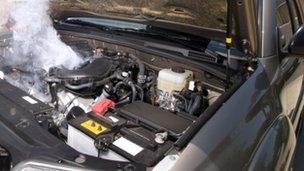Is the NHS going to blow a gasket?
- Published

The whole NHS system is under pressure, not just A&E
Too often we think of NHS services in isolation.
Take the current debate over A&E. The focus has been on what is happening in these units rather than how it fits in with the entire system.
But in many ways the NHS is like an engine.
It is made up of many different parts. If a problem develops in one area, it is likely to have an impact on the whole.
Each part either has to work harder to keep the car moving or if the strain becomes to much it breaks down.
The problems being encountered in A&E are proof of that.
Visits have risen by 50% in England in a decade and this winter A&E departments have started spluttering.
But to get a full picture of what is happening you need to look at the whole system.
Rises in demand are being seen everywhere in England.
GP consultations are up by a third since the mid 1990s.
Some of this workload has been passed on to hospitals with referrals for non-emergency care at one point during the 2000s rising by 15% a year. This in turn has prompted increasing restrictions being placed on referral processes in recent years.
Nonetheless, the number of routine operations carried out by hospitals, such as knee and hip replacements, has still jumped by 60% since the mid 1990s.
Rationing
There are signs the GP workload has had an effect on A&E too.
Amid complaints that doctors could no longer cope, they were allowed to relinquish responsibility for providing out-of-hours care in 2004.
This has been taken on by agencies, but with confidence in the system low there are large numbers of patients now attending A&E who do not need emergency care.
The College of Emergency Medicine estimates up to a third could be treated elsewhere.
But what is causing this?
The overall population has been rising, but not at such a rapid rate to explain these figures.
Instead, it is the complexity of the cases that has resulted in people needing more frequent help.
The ageing population has meant there are more people with multiple conditions, such as heart disease, dementia and respiratory problems.
These patients need careful managing and more help.
Take GP consultations. The average patient is now seen 5.5 times a year compared to less than four times in 1995.
A similar pattern has emerged in hospitals. Two thirds of patients are now over the age of 65.
A quarter of beds are taken up by those aged over 85 - and they spend much longer in hospital than younger patients (11 days on average compared to three for the under 65s).
The rises in demand have happened at a time when the number of hospital beds has been reduced too.
There are now 107,000 beds - down a third in the past 25 years.
But as well as seeing demand at the front-door rise, the NHS is finding it difficult to get patients out the other end.
Cuts to council budgets have meant they have had to ration social care, which affects the ability of hospitals to discharge frail and elderly patients as quickly as they should.
Luxury
Unsurprisingly, all this has resulted in hospitals becoming over worked.
According to recommendations, hospitals should only be 85% full to allow them to cope with surges in demand and provide the flexibility to allow patients to be moved around to the most appropriate areas.
An analysis last year by Dr Foster found once quiet periods, such as bank holidays and Christmas are stripped out, hospitals are running at 90% capacity.
In other words, they are too full.
This, of course, has an impact on the ability of A&E units to admit patients and get their treatment under way - hence the long waits that were experienced in many parts of the county this winter.
It may also ultimately drive up waiting times for non-emergency operations as hospitals struggle to fit in their routine patients around the emergency cases - a point made by NHS Confederation chief executive Mike Farrar when he appeared before MPs on the Health Select Committee this week.
However, the irony is that as soon as this problem has hit the headlines, the official figures have started suggesting the pressure is easing.
A&E data has been improving as the weather gets milder and within the next few weeks the major units should start hitting the waiting time target again.
But no-one should be fooled into thinking the issues have gone away.
Whereas in recent years there has been extra money to throw at problems, that luxury is no longer available.
The engine of the NHS may still be running, but under the bonnet all is not well.